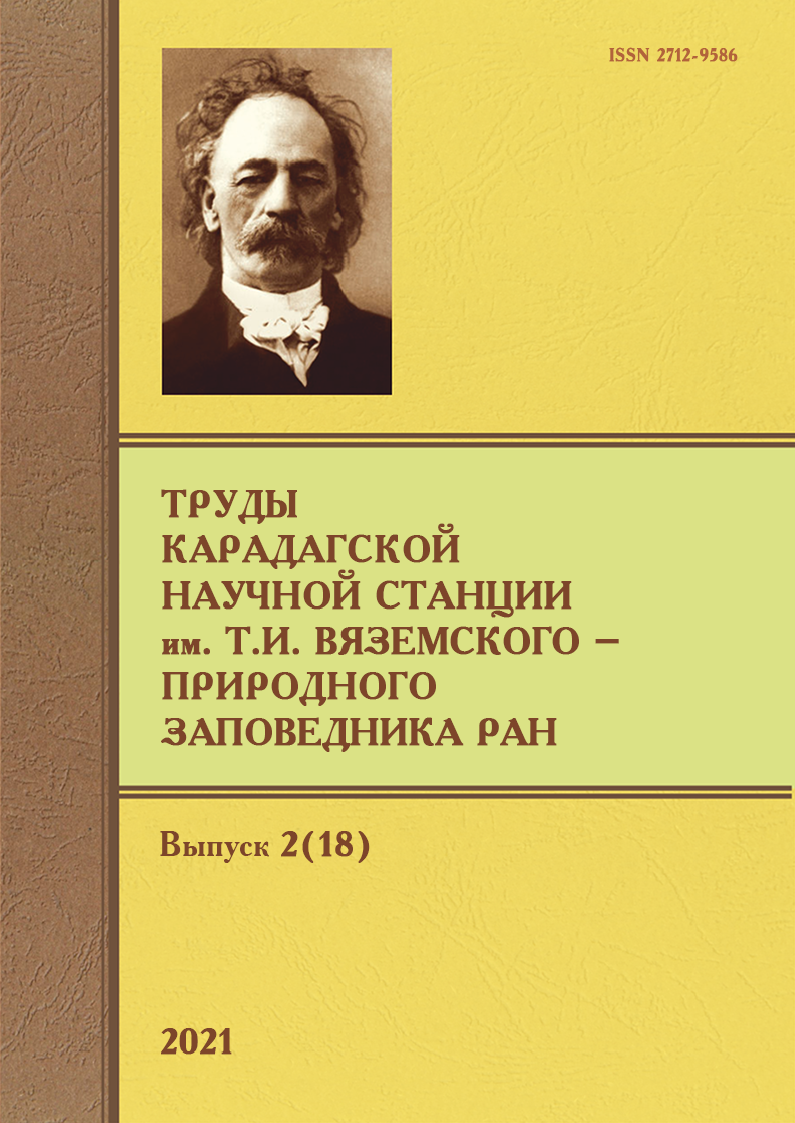Оценка биологически активной эритемной УФ-радиации и УФ-ресурсов в Крыму
##plugins.themes.ibsscustom.article.main##
##plugins.themes.ibsscustom.article.details##
Аннотация
Изучена временная динамика биологически активной эритемной УФ-радиации (Qery) и факторов, её определяющих, в 2018–2019 гг. на территории Государственного природного заповедника «Карадагский» (КНС — ПЗ РАН — филиал ФИЦ ИнБЮМ) в Крыму. Суточные суммы Qery изменялись более чем в 10 раз, от 67,6 Джм-2 до 5856 Джм-2, и в целом соответствовали сезонному ходу высоты Солнца, однако за счёт плотной облачности поступление УФ-радиации могло ослабляться более чем в 5 раз, влияя на её биологическое воздействие. На основании данных измерений Qery оценены УФ-ресурсы в разные месяцы года. В холодный период (ноябрь — январь), когда степень открытости кожи человека (S) составляет 0,1 и высота Солнца низкая, наблюдаются условия УФ-недостаточности, когда невозможно формирование витамина D уже для второго типа кожи. Наиболее благоприятные условия для проведения гелиотерапии при таких величинах S наблюдаются в марте и октябре для второго типа кожи, а для четвёртого типа — в апреле и сентябре. При увеличении доли открытости тела за счёт рук, лица и шеи (S = 0,3) формирование витамина D возможно в течение всего года для второго типа кожи. В декабре и январе повторяемость таких условий составляет 10–30 %. В тёплый период года в Крыму, в утренние или вечерние часы, практически всегда есть условия для формирования дозы Qery, необходимой для синтеза витамина D. Летом для четвёртого типа кожи наблюдаются условия УФ-оптимума или УФ-избыточности первой степени.
Авторы
Библиографические ссылки
Чубарова Н. Е. Пропускание суммарной УФ-радиации облаками различных типов // Известия Российской академии наук. Физика атмосферы и океана. – 1993. – Т. 29, № 5. – С. 639–645.
Чубарова Н. Е., Жданова Е. Ю. Ультрафиолетовые ресурсы при ясном небе на территории России // Вестник Московского университета. Серия 5, География. – 2012. – № 6. – С. 9–19.
Booth C. R., Madronich S. Radiation amplification factors: improved formulation accounts for large increases in ultraviolet radiation associated with Antarctic ozone // Ultraviolet Radiation in Antarctica: Measurements and Biological Effects / Eds: C. S. Weiler, P. A. Penhale. – Washington : American Geophysical Union, 1994. – P. 39–42. – (Antarctic Research Series ; vol. 62). – https://doi.org/10.1029/AR062p0039
Chubarova N., Zhdanova Ye. Ultraviolet resources over Northern Eurasia // Journal of Photochemistry and Photobiology. [Ser.] B, Biology. – 2013. – Vol. 127. – P. 38–51. – https://doi.org/10.1016/j.jphotobiol.2013.07.013
Dahlback A., Gelsor N., Stamnes J. J., Gjessing Y. UV measurements in the 3000–5000 m altitude region in Tibet // Journal of Geophysical Research. Atmospheres. – 2007. – Vol. 112, iss. D9. – Art. no. D09308 (10 p.). – https://doi.org/10.1029/2006JD007700
Environmental effects of ozone depletion and its interactions with climate change: 2014 assessment // Photochemical and Photobiological Sciences. – 2015. – Vol. 14, no. 1. – P. 14–18. – https://doi.org/10.1039/c4pp90042a
Fitzpatrick T. B. The validity and practicality of sun-reactive skin types I through VI // Archives of Dermatology. – 1988. – Vol. 124, no. 6. – P. 869–871. – https://doi.org/10.1001/archderm.1988.01670060015008
Pfeifer M., Koepke T. P., Reuder J. Effects of altitude and aerosol on UV radiation // Journal of Geophysical Research. Atmospheres. – 2006. – Vol. 111, iss. D1. – Art. no. D01203 (11 p.). – https://doi.org/10.1029/2005JD006444
Reuder J., Schwander H. Aerosol effects on UV radiation in nonurban regions // Journal of Geophysical Research. Atmospheres. – 1999. – Vol. 104, iss. D4. – P. 4065–4077. – https://doi.org/10.1029/1998JD200072
Tanskanen A. Lambertian Surface Albedo Climatology at 360 nm from TOMS Data Using Moving Time-WindowTechnique//ProceedingsoftheXXQuadrennialOzoneSymposium,1–8June2004, Kos, Greece / Ed. C. S. Zerefos. – Athens : International Ozone Commission, 2004. – P. 1159–1160.
Vanicek K., Frei T., Litynska Z., Schmalwieser A. UV Index for the Public : a guide for publication and interpretation of solar UV Index forecasts for the public : COST-713 Action. – Luxembourg : Office for Official Publications of the European Communities, 2000. – 27 p. – (EUR/European Commission ; 19226).

 Google Scholar
Google Scholar